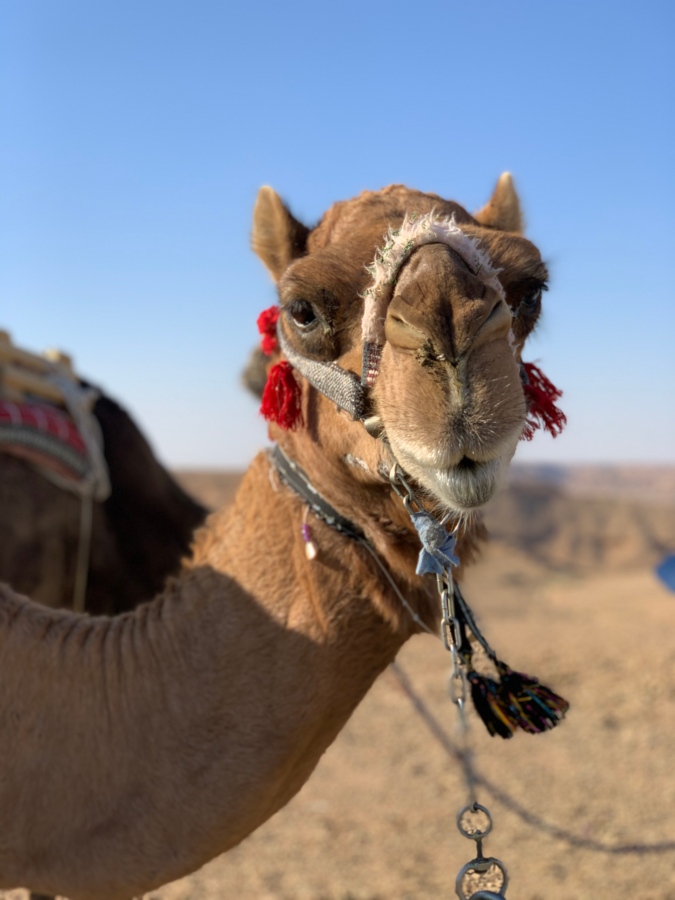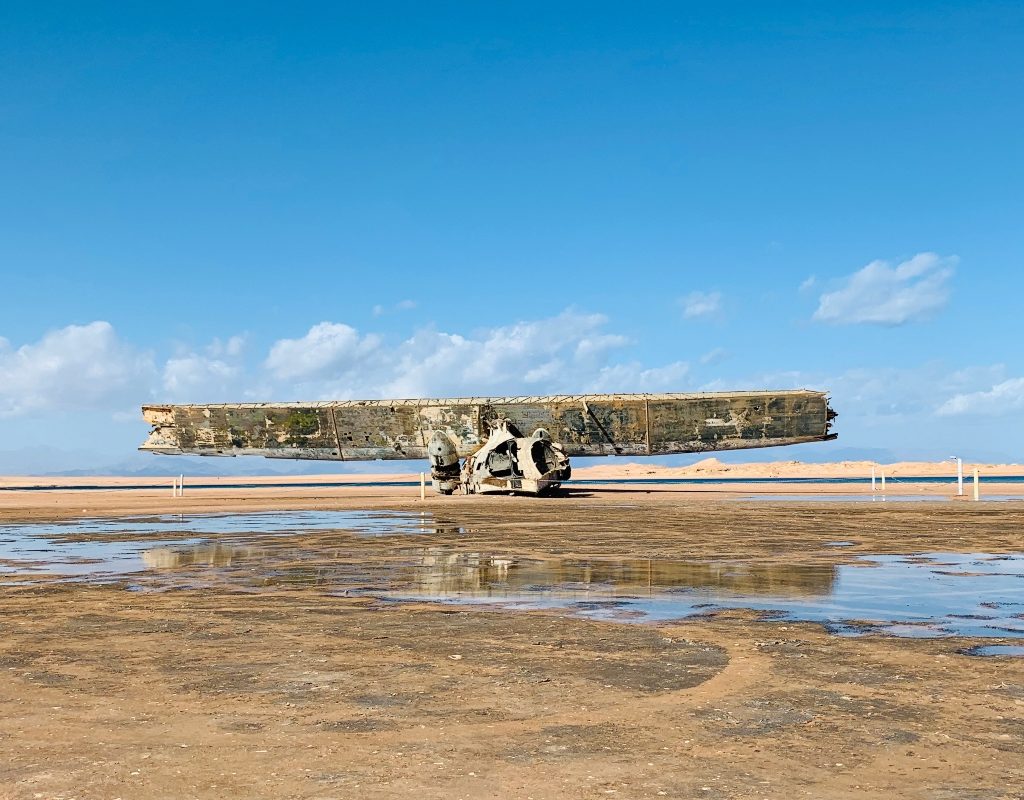Three days in Tabuk
Day 1
Jebel Al-Lawz
Most people are under the misconception that Saudi is all about the sand dunes. Saudi has a few mountain peaks, with Jebel Al-Lawz (2,580 m) being one of them. Located in northwestern Saudi Arabia near the Jordanian border, this is one of the very few places in Saudi Arabia where it snows in winter. It takes around 2 hours to get to Jebel Al-Lawz from Tabuk. With its never-ending winding roads, the drive up the mountains was really fascinating.
The highest viewpoint you can get to is just over 2,000 meters above sea level where you have incredible aerial views of other rocky mountains.
It was around 10°C (50°F) when I visited in December but the wind made it feel much colder so make sure you have a warm jacket!

Wadi Al-Disah
With its striking red cliffs, imposing rock formations, streams and abundant palm trees, Wadi Al Dissah is a paradise for photographers. Wadi Al Dissah is a 15 km long canyon, 80 km south of Tabuk.


If you like camels like me, you will love this place! You will see plenty of them here, either in herds or even occasionally alone.

Thanks to natural springs, the streams in Tabuk province provide a source of irrigation for fruit orchards here. Yes, you have fruit orchards in Saudi Arabia (who would have thought?)! Here you will find mango, orange and lemon trees. The locals mentioned that the Prophet Muhammad, who spent a few years in Tabuk, made a prophecy that the region would be full of fruit orchards in return for the support that the locals had given him.

Day 2
Catalina seaplane wreckage

The abandoned wreckage of a 1930 American military seaplane is now a tourist attraction in Strait of Tirana, Tabuk. Originally used in WWII, the plane was later purchased by Mr. Kendall in the 1950s. Mr. Kendall used this plane for his luxurious family vacations. He landed in the Strait of Tirana, Saudi Arabia in 1960 with his family. It was here that his plane was attacked by Bedouins, who suspected the Kendalls to be Israeli spies. Mr. Kendall and his family, however, managed to survive and were sent back to the US after a brief interrogation.
The Catalina seaplane is located 260 km from Tabuk city in Ras AlSheikh Hamid.
Admission: Free (as of Dec 2019)
The Red Sea
The drive from Tabuk to Makna is across the road, which runs parallel to the Red Sea. There are multiple places where you can stop to appreciate the turquoise Red Sea and the Sinai Mountains in Egypt behind it. Did you know that Moses spent 10 years in Tabuk in voluntary exile after killing an Egyptian slavemaster who was beating a fellow Hebrew?

Moses’ Spring in Makna
These springs are located in the valley of Makna, 200 km from the city of Tabuk. I was told that Moses spent 10 years in Makna, Saudi Arabia, in exile but none of the locals, including my driver, could explain to me why it’s called Moses’ Spring. The spring is surrounded by a beautiful palm grove, with the water coming up from various places in the rock. After some research, I found out that it is named after Moses as it is one of two possible places where he struck the rock with his staff to get water.
Tayeb Al-Ism
This place is another geological wonder! You are faced by gigantic cliffs with a narrow corridor at the entrance. There is a small stream, which runs through the corridor. We hiked for almost an hour. The wind blowing through the corridor made the temperature quite cool. The chirping of the birds makes the place even more beautiful as the birdsong resonates throughout it.

Tombs of Mugha’ir Shoaib
Located in Madyan, about 200 km from the city of Tabuk.
These tombs were carved out of the mountains of Tabuk province by the Nabataeans in the 1st century AD. They reminded me of the archeological site of Petra in Jordan, which I visited in 2012. It’s amazing how they are still so well-preserved despite their age. The tombs are simple from inside with multiple graves. The art on the exteriors of the tombs reflects the status of the people buried inside.
Admission: Free (as of Dec 2019)

Day 3
Al Shaq Canyon – The Great Canyon of Saudi Arabia
Arizona isn’t the only place you will find canyons. Saudi has quite a few impressive canyons to boast about, like Al Shaq in Tabuk province. The name of the canyon in Arabic means “tear/rip”, which is quite apt as the land here was torn apart by the movement of tectonic plates 150 million years ago.

Here I also met a group of young Bedouins, who were here for a picnic. I greeted them by saying “Merhaba” (“hello” in Arabic). They insisted that I join them for coffee, which I did. They didn’t speak any English but my driver translated where required. The Bedouins are a nomadic tribe found in the Arabian Peninsula, particularly known for their hospitality.
When I mentioned that I am from India, they said “Shahrukh Khan! Kareena Kapoor”. Given the influence of Bollywood in Saudi Arabia, like rest of the Middle East, India is almost synonymous with Bollywood stars, especially Shahrukh Khan. Saudi Arabia barely gets any tourists, given they only recently started issuing tourist visas. The Bedouins feel very happy if they see people visiting from outside. They took selfies with me on their phones and even danced with me to their local Bedouin music! I was totally loving the V.I.P. treatment!

I was overwhelmed by the hospitality of the Bedouins. If you were to ask me about my most memorable experience in Saudi Arabia, I would definitely say being invited by the Bedouins for coffee! Generally, one would pay for cultural experiences when one travels to understand local culture and traditions. This was truly authentic. Non-transactional! Experiences like these really enrich one’s experience of a place.

There’s something I learnt from the Bedouins. It was about how to be content despite leading an austere, simple lifestyle. The Bedouins lead a difficult lifestyle in the rugged dessert terrain of Saudi Arabia. They live in tents made of camel skin and keep camels as their source of livelihood. Despite leading an austere lifestyle, they seemed happy and content! What I also admired was that at a young age they were taking forward the Bedouin customs of hospitality!
Jibal Hisma
I was somewhat regretting that I wasn’t able to cover Wadi Rum in my trip to Jordan in 2012 but I was glad to finally see similar landscapes on the Saudi side (with fewer crowds!). The landscape is nothing like anything I have seen before. The red-brown sand and alien-looking rock formations make you feel that you are on Mars.


For those of you who didn’t know, the geological formations spanning Wadi Rum in Jordan and the Tabuk region in Saudi Arabia were a result of movement in tectonic plates 150 million years ago.
The scene at twilight with the pink and orange sky, the moon and a couple of stars visible and the sphinx like rock structures in the background of the wood fire while enjoying my mint tea was surreal.

The evening ended with a bonfire and camel meat cooked with rice prepared by my driver Mohammed. It’s the first time I tried camel meat. It was certainly better than I had expected it to be, but I wouldn’t say it’s my favourite meat.




I’ve read this article a few times already and no matter how many times I read it, it still feels as good as it did the first time I read. Absolutely love those rocky mountains and valleys. The pictures with sunrays falling on the majestic cliffs are stunning. As a reader, I too feel very happy reading about your experience with Bedouins. Their hospitality is indeed heart-warming. Can only imagine how good it must be in the company of such loving people. Hope people get to see all the beauty that KSA has to offer.
I’m so glad you share your experience in Tabuk, i feel like it’s so wonderful when we will reach this place, this is one of the place we plan to visit next month, me and my husband. We will have a road trip to explore Saudi Arabia.
Thank you and more fun in your travel!